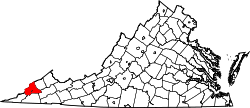Cranes Nest, Virginia | |
|---|---|
Unincorporated community | |
| Coordinates: 36°58′26″N82°28′21″W / 36.97389°N 82.47250°W | |
| Country | United States |
| State | Virginia |
| County | Wise |
| Elevation | 2,021 ft (616 m) |
| Time zone | UTC-5 (Eastern (EST)) |
| • Summer (DST) | UTC-4 (EDT) |
| GNIS feature ID | 1502783 [1] |
Cranes Nest is an unincorporated community and coal town located in Wise County, Virginia, United States.


